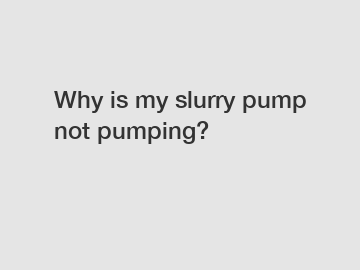Why is my slurry pump not pumping?
Is your slurry pump not pumping as it should be? If so, you're not alone. Slurry pumps are essential equipment in many industries, including mining, construction, and sewage treatment. When they stop working efficiently, it can cause significant disruptions and delays in operations. But fear not, there are several common reasons why a slurry pump may not be pumping properly, and solutions to get it back up and running smoothly.
One of the most common reasons for a slurry pump not pumping is a clogged impeller. The impeller is the rotating component of the pump that generates the centrifugal force needed to move the slurry through the system. Over time, the impeller can become clogged with debris, reducing its efficiency and preventing proper pumping. To fix this issue, the impeller should be cleaned thoroughly to remove any build-up of material. This can be done by disassembling the pump and using a brush or compressed air to clear out any obstructions.
Another common reason for a slurry pump not pumping is a worn or damaged impeller. As the impeller rotates at high speeds, it can become worn down or damaged, leading to decreased pumping efficiency. In this case, the impeller will need to be replaced with a new one to restore the pump's functionality. It's important to regularly inspect the impeller for signs of wear and tear, such as cracks or chips, and replace it as needed to prevent further damage to the pump.

Sometimes, a slurry pump may not be pumping due to air leaks in the suction line. Air leaks can disrupt the flow of slurry through the pump, causing it to lose suction and fail to pump effectively. To address this issue, the suction line should be checked for any leaks or cracks and repaired as necessary. Additionally, ensuring that all connections are secure and properly sealed can help prevent air leaks from occurring in the first place.
A lack of priming can also cause a slurry pump to stop pumping. Priming is the process of filling the pump with liquid to create the necessary suction for pumping. If the pump is not properly primed, it will not be able to effectively move the slurry through the system. To address this issue, the pump should be primed according to the manufacturer's instructions before operation. This may involve manually filling the pump with liquid or using a priming pump to create the necessary suction.
Finally, a slurry pump may not be pumping due to an inadequate power supply. Slurry pumps require a certain amount of power to operate efficiently, and a lack of power can cause them to underperform or stop working altogether. If your slurry pump is not pumping as it should be, check the power supply to ensure that it is providing the necessary voltage and current. If the power supply is insufficient, it may be necessary to upgrade to a higher-capacity power source to ensure proper pump operation.
In conclusion, there are several common reasons why a slurry pump may not be pumping effectively, including a clogged impeller, worn or damaged components, air leaks, lack of priming, and inadequate power supply. By identifying and addressing these issues, you can get your slurry pump back up and running smoothly, ensuring that your operations continue to run efficiently. If you are experiencing problems with your slurry pump, don't hesitate to reach out to a professional for assistance. Remember, regular maintenance and inspection are key to preventing issues with your slurry pump and ensuring its long-term performance.
If you are looking for more details, kindly visit sludge pump types, single stage slurry pump, sludge pump types.

Comments